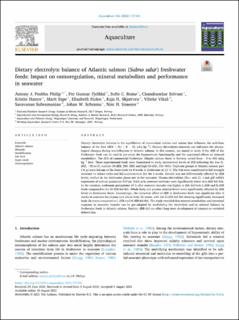| dc.description.abstract | Dietary electrolyte balance is the equilibrium of monovalent cations and anions that influence the acid-base balance of the feed (dEB = Na + K − Cl, mEq kg−1). Dietary electrolytes/minerals can influence the physiological changes during smoltification in Atlantic salmon. In this context, we aimed to study if the dEB of the freshwater feeds can be used to pre-adapt the hypoosmotic functionality and the associated effects on mineral metabolism. The dEB of commercial freshwater Atlantic salmon feeds in Norway varied from −9 to 400 mEq kg−1 feed. Three experimental feeds were formulated to study incremental levels of dEB reflecting the low (L-dEB, −50 to 0), median (M-dEB, 200–250) and high (H-dEB, 350–400). Triplicate groups of Atlantic salmon parr (36 g) were fed one of the three feeds for 8 weeks in freshwater at 12 °C. The fish were transferred to full strength seawater in indoor tanks and fed a commercial diet for 6 weeks. Growth was not differentially affected by dEB levels, neither in the freshwater phase nor in the seawater. Plasma electrolytes (Na+ and Cl−) and gill mRNA expression of sodium potassium ATPase (NKA a1b, seawater isoform) were significantly lower in L-dEB fed fish. In the intestine, carbonate precipitates 24 h after seawater transfer was higher in fish fed both L-dEB and H-dEB feeds compared to the M-dEB fed fish. Whole body and plasma mineral levels were significantly affected by dEB levels in freshwater feeds. Interestingly, the carryover effect of dEB in freshwater feeds was significant after 6 weeks in seawater for plasma and whole-body Zn status, with the H-dEB fed fish showing significantly increased body Zn status compared to L-dEB and M-dEB fed fish. The study revealed that mineral metabolism and intestinal response to seawater transfer can be pre-adapted by modulating the electrolyte and/or mineral balance in freshwater feeds in Atlantic salmon. Further, dEB did not affect long term development of cataract or vertebral deformities. | en_US |
